Learn about 17 Types of Indoor Palm Plants to make your living space more inviting and bring a tropical touch to your interior.
Palm plants bring a tropical touch, feeling of peace, and tranquility to any space. They are usually low maintenance and thrive well as houseplants. These slow growers can be between 3 to 8 feet in height and help in purifying indoor air, making them a favorite of interior designers. If you’re a palm fan too and looking to grow them as a houseplant, then this list of 17 Types of Indoor Palm Plants is going to help you a lot!
Have a look at indoor palm benefits proven in studies here
1. Areca Palm

Botanical Name: Dypsis lutescens
Other Names: Golden Cane Palm, Butterfly Palm or Yellow Palm
Areca palm is a popular houseplant due to its ability to remove formaldehyde, xylene, and toluene. This palm attains an average height of 4-12 feet and spans 3-5 feet wide.
Growing Tips:
- Provide enough humidity.
- Avoid overwatering.
2. Chinese Fan Palm
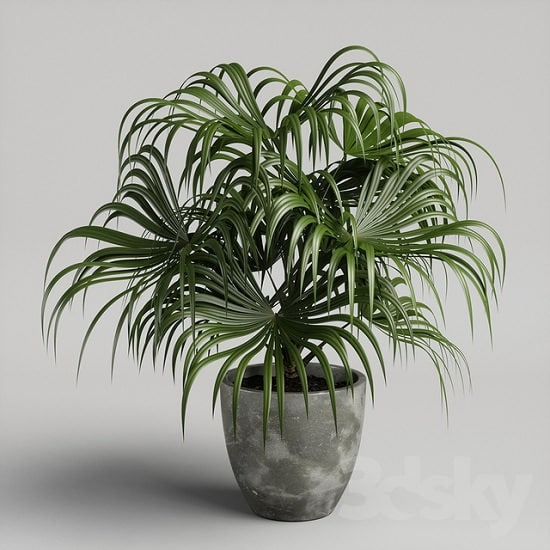
Botanical Name: Livistona chinensis
Other Name: Fountain Palm
Fan-shaped, large leaves of this palm variety provides it a unique look and sets the plant apart among other palms. It grows up to 10 feet tall, spreading 2-4 feet with broad, elegant foliage.
Growing Tips:
- Fertilize during the growing season.
- Water when the topsoil is dry.
3. Parlor Palm
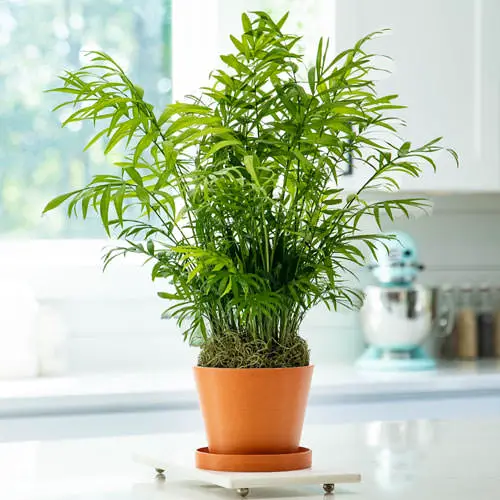
Botanical Name: Chamaedorea elegans
Other Name: Neanthe Bella Palm
The fine-textured parlor palm gained popularity as a houseplant due to its quick adaptability to low or artificial light settings. It acquires 2-6 feet height and spreads 2-3 feet.
Growing Tips:
- Water regularly but avoid overwatering.
- Protect it from cold drafts.
4. Ponytail Palm
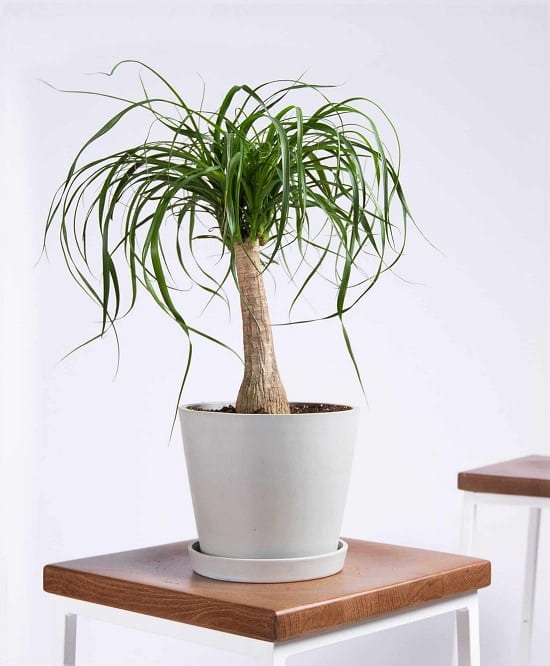
Botanical Name: Beaucarnea recurvata
Other Names: Elephant’s Foot Palm, Bottle Palm
This ornamental palm is actually a succulent. It’s a perfect choice for corners. The delicate curly leaves with a foot-like trunk give it an extraordinary appearance. Furthermore, it’s drought-tolerant and also purifies the indoor air.
Growing Tips:
- It needs occasional watering.
- Indirect sunlight is sufficient for its growth.
Also Read: 14 Indoor Plants That Need Water Once A Month
5. European Fan Palm
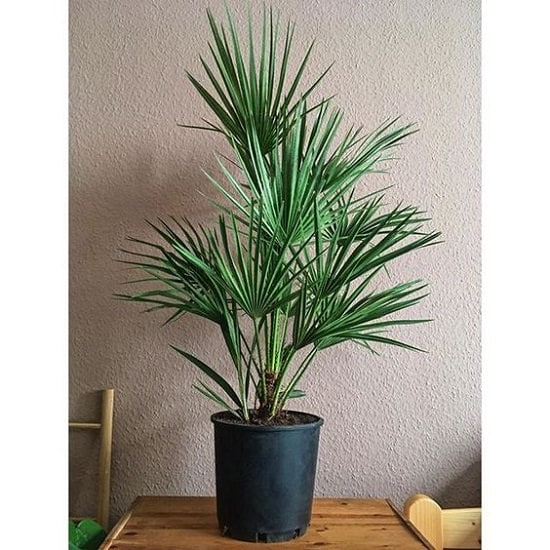
Botanical Name: Chamaerops humilis
Other Names: Mediterranean Fan Palm, Dwarf Fan Palm
European fan palm can be a large centerpiece of your room with its unique fan-like appearance. This winter-hardy palm is native to Europe; its gray-green triangular fine-textured leaves can usually spread up to 2 feet on 4 feet tall stems.
Growing Tips:
- It requires filtered sunlight.
- Keep the soil moist during summers. But water only when top one-inch soil gets dry.
6. Kentia Palm

Botanical Name: Howea forsteriana
Other Names: Thatch Palm, Paradise Palm
One of the most popular types of indoor palm plants of the Victorian era, Kentia palm is a slow grower that can reach a maximum height of 10 feet. Grow it if you want to have a large houseplant in your home.
Growing Tips:
- Place it in indirect sunlight.
- It prefers warm temperature above 60 F (15 C)
7. Pygmy Date Palm
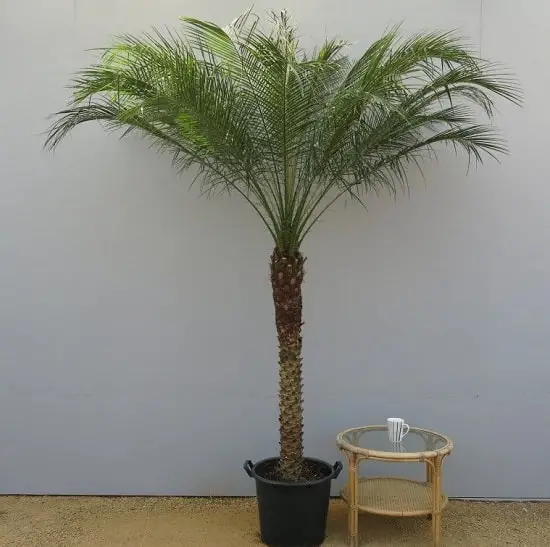
Botanical Name: Phoenix robelinii
Other Name: Miniature Date Palm
This NASA air-purifying plant belongs to date palms. With ornamental long and thin leaves, it reaches the height of 4-6 feet in pots, quite a manageable size indoors. When grown in warm surroundings and ample sunlight, it also produces edible mini-dates.
Growing Tips:
- It prefers partial sunlight.
- Feed the plant once a month, from spring to autumn, with diluted liquid fertilizer.
8. Lady Palm
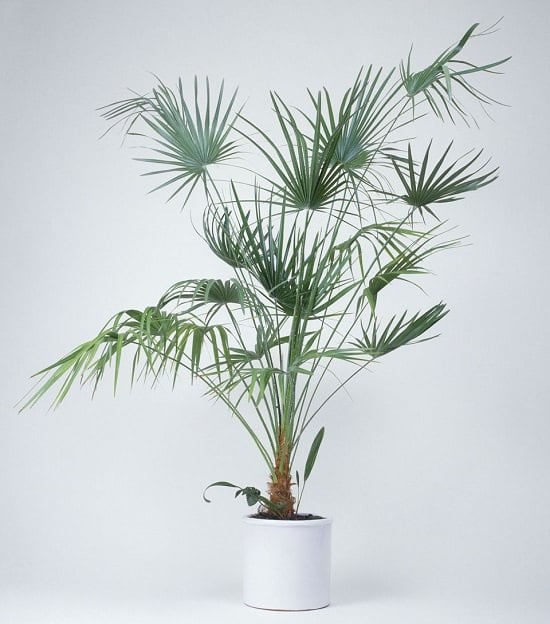
Botanical Name: Rhapis excelsa & Rhapis humilis
Other Names: Broadleaf Lady, Little Lady Palm, Finger Palm, Bamboo Palm
Both these lady palm varieties have fan-like foliage that looks like delicate fingers. Interestingly, this is one of the rare palms that has both green and variegated leaves.
Growing Tips:
- This palm can grow in indirect sunlight.
- It requires constant moisture but not soggy soil.
9. Sago Palm
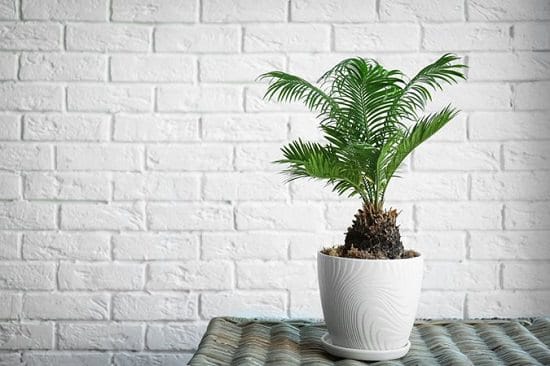
Botanical Name: Cycas revoluta
Other Names: Cycas Palm, Sago Palm
Though it is not a true palm, it looks like one due to its feathery fronds. The sago palm is a slow-growing species, reaching 2 feet tall in approx five years. Learn everything about growing this plant here.
Growing Tips:
- Dry soil is perfect for its growth.
- The sago palm grows best in bright indirect sunlight.
Also Read: How to Grow Sago Palm
10. Fishtail Palm
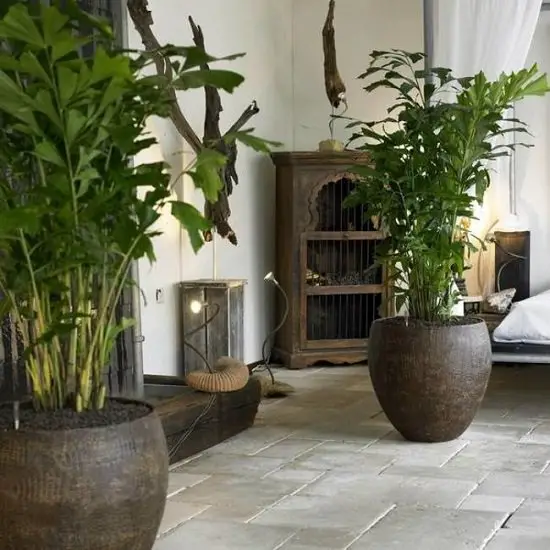
Botanical Name: Caryota mitis
Other Names: Fishtail Palm, Clustering Fishtail Palm, Clumping Fishtail Palm
The large bipinnate leaves with a triangular shape, look quite similar to a fishtail. It quickly adjusts in indoor conditions. You can even grow it in a bathroom or laundry room if space is available. This slow-growing plant can be 6 to 8 feet tall indoors.
Growing Tips:
- It needs a minimum temperature of 60 F.
- Keep the soil moist with a moderate watering schedule.
11. Ruffled Fan Palm
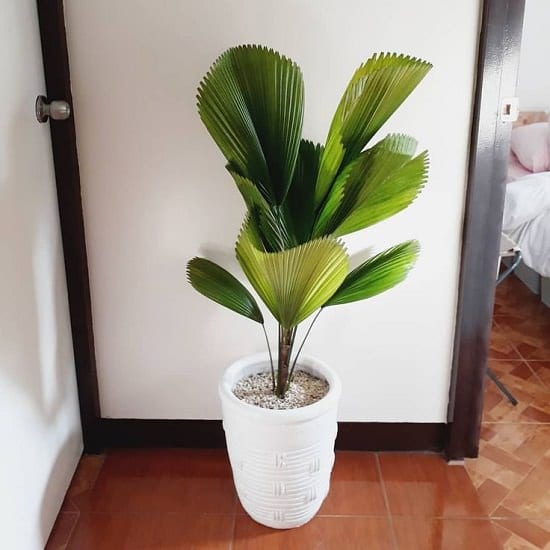
Botanical Name: Licuala grandis
Other Names: Vanuatu Fan Palm, Palas Fan Palm
This elegant palm showcases glossy fan-like fronds, it’s low maintenance and grows at a slow pace like other types of palms. While growing indoors, it usually remains around 4 to 6 feet tall.
Growing Tips:
- It prefers humid conditions.
- Position the plant in partial sunlight.
12. Cat Palm
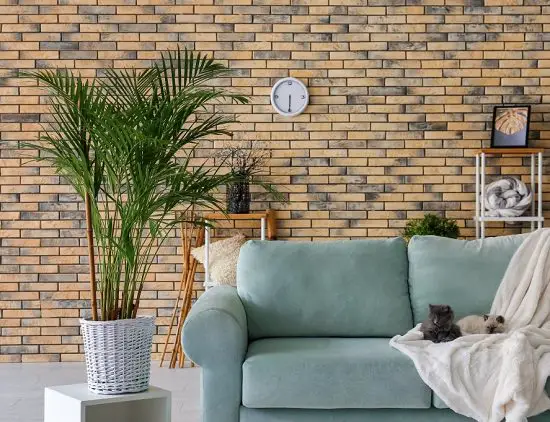
Botanical Name: Chamaedorea cataractarum
Other Names: Cascade Palm, Cataract Palm
This tropical palm grows in glossy dark green leaves on small shoots that add a dramatic touch to your interior. It grows in a stemless clump, attaining a height up to 6 feet indoors; you can restrict the growth by regular pruning as well.
Growing Tips:
- It flourishes in bright indirect sunlight.
- Keep the moisture of the soil even, but avoid overwatering.
13. Yucca
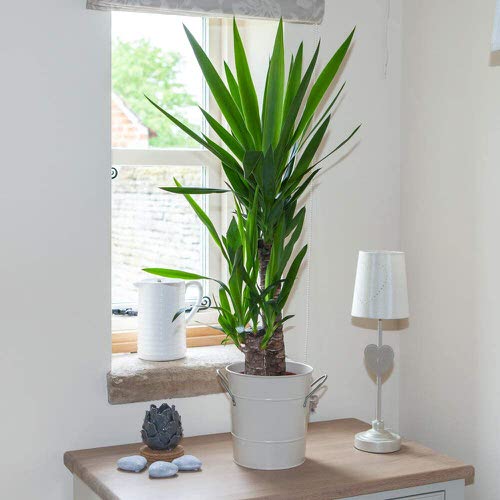
Botanical Name: Yucca elephantipes
Other Names: Spineless Yucca, Stick Yucca
This variety of yucca looks like a miniature palm tree or dragon tree Dracaena, it’s an ideal candidate for modern interior decor. Though it can be a tall tree outdoors, you can grow it indoors for several years until it becomes too big to handle.
Growing Tips:
- Provide bright indirect sunlight, exposure to 2-3 hours of direct morning sun is ideal.
- It grows best in well-drained soil.
14. Sentry Palm
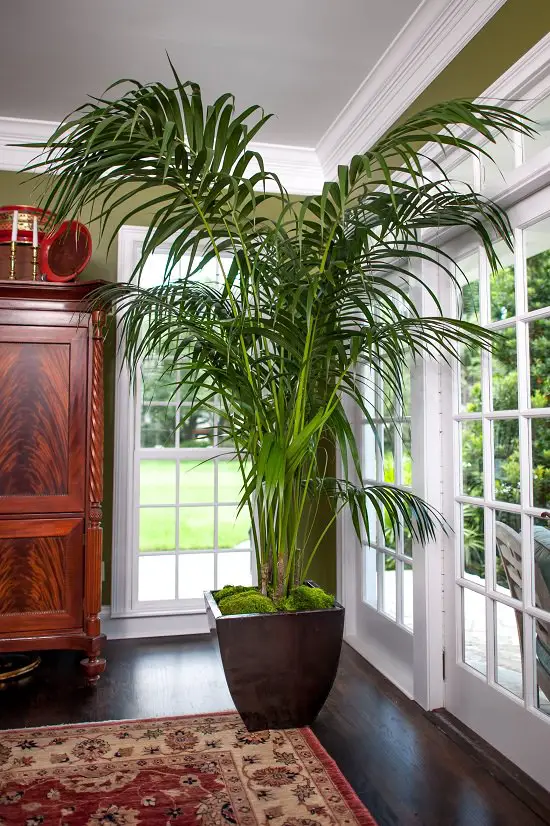
Botanical Name: Howea belmoreana
Other Names: Curly Palm, Belmore Palm
This palm is quite similar to the kentia palm, growing feather-like, broad curly fronds, making it more appealing for large rooms or corners. It grows up to 8 feet tall, though, you can prune its length to suit your needs.
Growing Tips:
- Place the plant in indirect, partial sunlight.
- It prefers high humid conditions, so mist the plant during dry spells.
15. Bamboo Palm
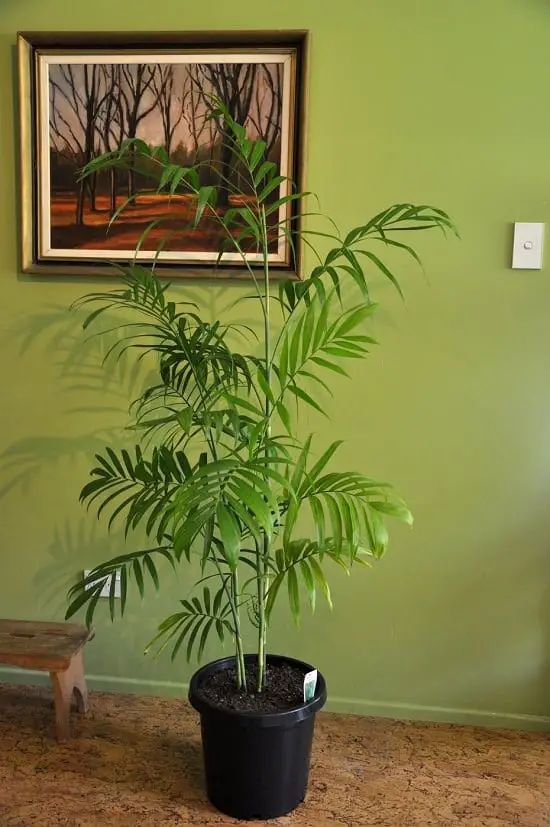
Botanical Name: Chamaedorea seifrizii
Other Name: Reed Palm
Potted bamboo palm can enhance the beauty of any interior decor. It can reach up 5-7 feet tall with 3-5 feet spread, growing in clumps with multiple reed-like stems. Besides that, according to NASA, the bamboo palm also cleanses and purifies indoor air, making it perfect for bedrooms.
Growing Tips:
- Nourish your plant with bright, indirect sunlight.
- Water the plant thoroughly in springs and summers, but less frequently in winters.
16. Majestic Palm
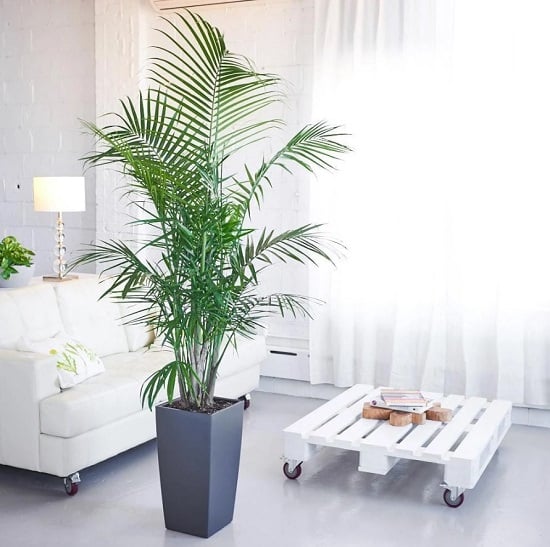
Botanical Name: Ravenea rivularis
Other Name: Majesty Palm
The upward arching, dark green fronds of majestic palm, can uplift an empty corner of your room with its larger than life appearance. This shade-resistant plant is a slow grower; hence, it is a perfect choice as a houseplant.
Growing Tips:
- It requires consistent moisture and humidity.
- Majestic palm can thrive in low-light conditions. Bright, indirect sunlight also works well.
17. Christmas Palm
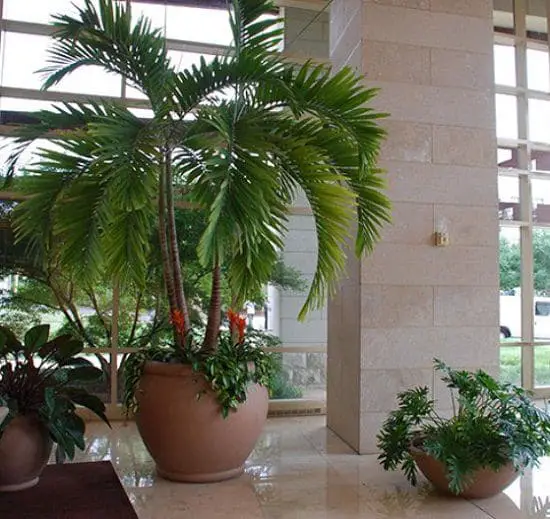
Botanical Name: Adonidia merrillii
Other Name: Manila Palm
Native to the Philippines, this ornamental palm variety produces red-colored fruits in winters. They give a decorative look to the plant, especially during the holiday season. It quickly reaches up to 6 feet in height and grows slowly post that.
Growing Tips:
- Though it grows in full sun in tropical areas, it can also tolerate partial shade as well.
- This plant needs frequent watering during its growth period.



Hi I am a nursery owner I want all types of palm seeds are you have available?
Personally, I have Howea forsteriana, which requires constant pruning, but it’s worth it. If I were to grow it in my garden, it would be bigger than if I were growing it indoors. It could grow up to 40 feet tall.